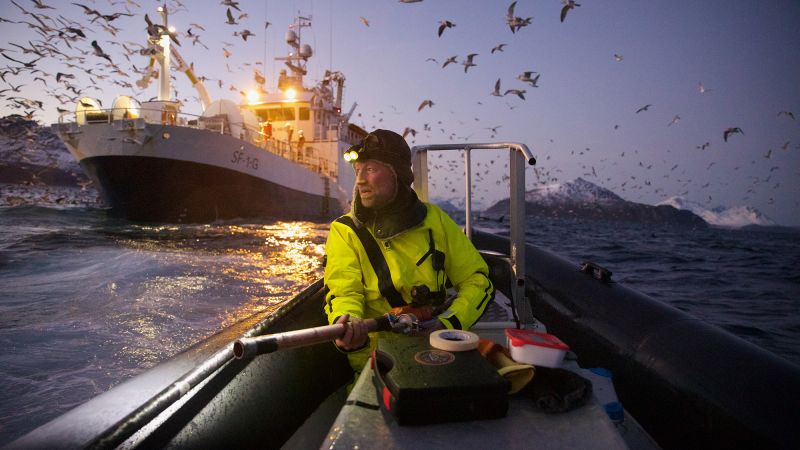Sign up for CNN’s Wonder Theory science newsletter. Explore the universe with news on fascinating discoveries, scientific advancements and more.
CNN
—
Pressed into a piece of rock is the flattened, 47 million-year-old body of a cicada. Measuring about 1 inch (26.5 millimeters) long with a wingspan of 2.7 inches (68.2 millimeters), its fossilized form is nearly intact, with its veined wings spread wide.
Scientists recently described the insect as a new genus and species, using this fossil and one other that was nearly as well preserved, from the same site. Even though the specimens are female, their location on the cicada family tree suggests that males of this species could sing as modern cicadas do. Found in Germany decades ago, their presence there reveals that singing cicadas dispersed in Europe millions of years earlier than once thought.
The fossils are also the oldest examples of “true” singing cicadas in the family Cicadidae, researchers reported April 29 in the journal Scientific Reports. Most modern cicadas belong to this family, including annual cicadas that appear every summer worldwide, as well as broods of black-bodied and red-eyed periodical cicadas, which emerge from May to June in eastern North America in cycles of 13 or 17 years. Brood XIV, one of the biggest broods, emerges across a dozen US states this year. Cicadas are found on every continent except Antarctica, and there are more than 3,000 species.
The fossil record for insects in general is abundant in just a few dozen locations, and while modern cicada species are numerous today, paleontologists have documented only 44 Cicadidae fossils. The earliest definitive fossil of a singing cicada was discovered in Montana and dates from 59 million to 56 million years ago, said lead study author Dr. Hui Jiang, a paleontologist and researcher with the Bonn Institute of Organismic Biology at the University of Bonn in Germany. Its newly described relative is the earliest singing cicada from Europe, Jiang told CNN in an email.
Because the body structures of the European fossils were so well preserved, scientists were able to assign the ancient insect to a modern tribe of cicadas called Platypleurini, “which is today primarily distributed in tropical and subtropical regions of sub-Saharan Africa and Asia, but is absent from Europe,” Jiang said.
Prior research suggested that this lineage evolved in Africa about 30 million to 25 million years ago and dispersed from there, according to Jiang. “This fossil pushes back the known fossil record of sound-producing cicadas in the tribe Platypleurini by approximately 20 million years, indicating that the diversification of this group occurred much earlier than previously recognized,” the researcher added.
The discovery hints that this group of cicadas evolved more slowly than prior estimates from molecular data proposed, said Dr. Conrad Labandeira, a senior research geologist and curator of fossil arthropods at the Smithsonian Museum of Natural History in Washington, DC.
“This suggests that older fossils of the Platypleurini are yet to be discovered,” said Labandeira, who was not involved in the research. “Such discoveries would assist in providing better calibrations for determining a more realistic evolutionary rate.”
Researchers named the cicada Eoplatypleura messelensis. Its name refers to where the specimens were discovered: the Messel Pit in Germany, a rich fossil site dating to the Eocene epoch (57 million to 36 million years ago). Excavated in the 1980s, the fossils have since been in the collection of the Senckenberg Research Institute and Natural History Museum Frankfurt in Germany, said senior study author Dr. Sonja Wedmann, head of Senckenberg’s paleoentomology department.
A very deep volcanic lake, with a bottom where no oxygen penetrated, once filled the Messel Pit. That environment created ideal conditions for fossilization, and fine-grain sediments from this former lake bed hold a variety of Eocene life, Wedmann told CNN in an email.
“The excellent preservation not only of insects, but of all groups of organisms, is the reason why Messel is an UNESCO world heritage site,” a designation it earned in 1995, Wedmann said.
The more complete of the two cicada fossils “is one of the best preserved insects from the Messel pit fossil site,” Wedmann added. “Senckenberg has a collection of over 20,000 fossil insects from Messel, and among these it stands out because of its really beautiful and complete preservation.”
In its overall head and body shape, E. messelensis strongly resembles modern cicadas. Its rostrum — a snoutlike mouth — is intact, but closer analysis is needed to tell whether it used the rostrum for feeding on plant tissues called xylem, as most modern cicadas do, Labandeira said.
E. messelensis also shows hints of colors and patterns in its wings. This feature camouflages modern cicadas as they cling to tree trunks, and it may have served a similar purpose for E. messelensis, according to Jiang.
However, E. messelensis differs from modern cicadas in subtle ways. For example, its forewings are broader and less elongated than those of species alive today, which may have affected how it flew.
Would the ancient cicada’s call have sounded like those of its modern relatives? “We can’t know the exact song,” Jiang said. However, based on the cicada’s body shape and placement in the singing cicada group, “it likely produced sounds similar in function to modern cicadas.”
When Brood XIV emerges in the billions in the late spring and early summer of 2025, their calls will measure from 90 to 100 decibels — as loud as a subway train. Other types of cicadas produce an even bigger ruckus: Songs of the African cicada Brevisana brevis peak at nearly 107 decibels, about as loud as a jet taking off.
The volume of the ancient species’ songs may have been even louder than that, Jiang said. The abdomen of E. messelensis is broader and larger than those of its modern relatives, suggesting that males could have had a larger resonating cavity. This cavity may have amplified sound from the vibrating structures in their abdomens, called tymbals, to produce a louder buzz.
“Of course, this is only a hypothesis,” Jiang added. “Future studies on how morphology relates to sound production in modern cicadas will help to test it.”
Mindy Weisberger is a science writer and media producer whose work has appeared in Live Science, Scientific American and How It Works magazine.

























